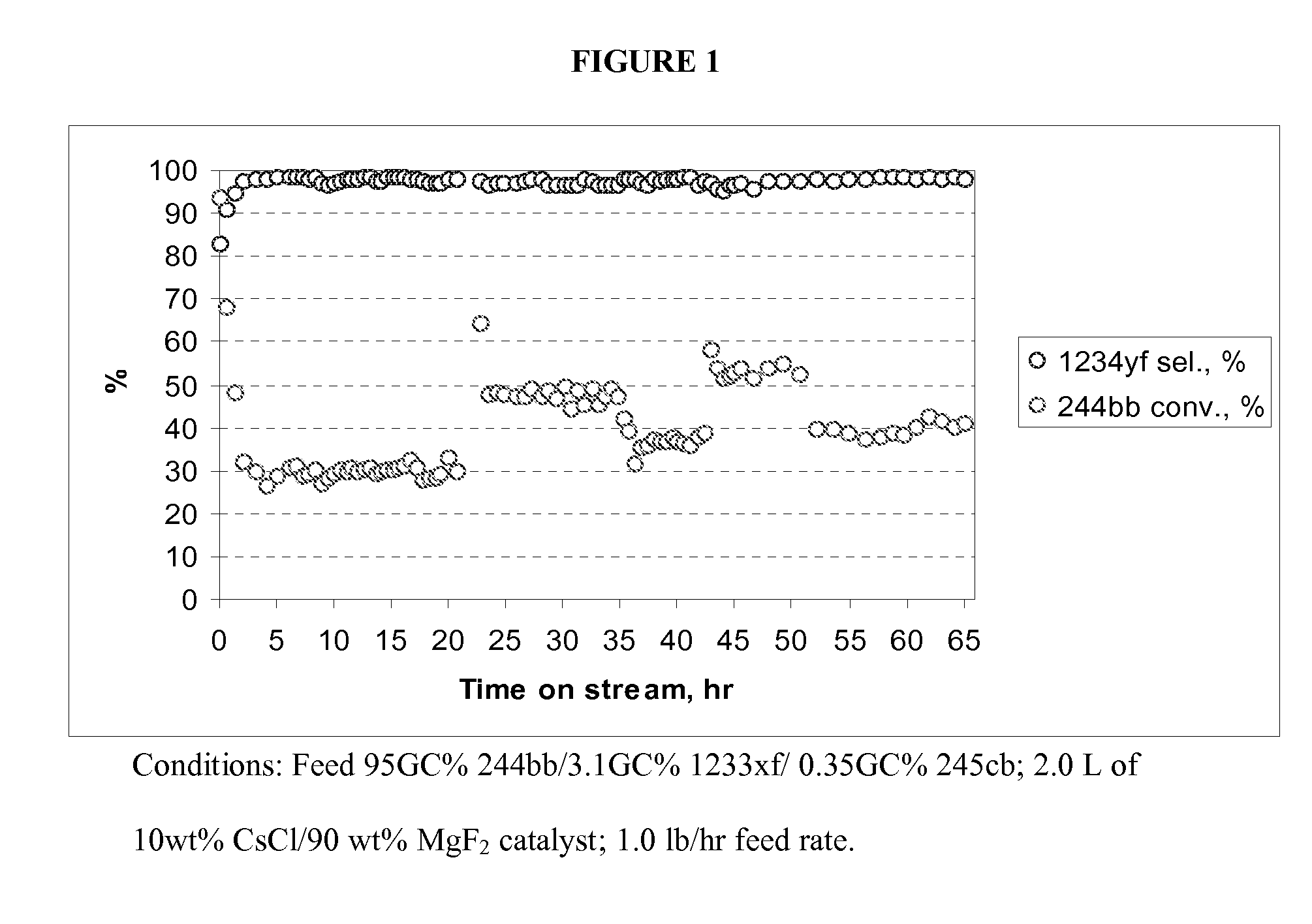Method for producing fluorinated organic compounds
a technology of organic compounds and fluorinated compounds, which is applied in the field of methods for preparing fluorinated organic compounds, can solve the problems of large percentage of unwanted and/or unimportant byproducts, high cost of hydrogen gas production, and high temperature of hydrogen gas,
- Summary
- Abstract
- Description
- Claims
- Application Information
AI Technical Summary
Problems solved by technology
Method used
Image
Examples
example 1
Continuous Liquid Phase Preparation of CF3CFClCH3 (HCFC-244bb) from CCl2═CClCH2Cl
[0064]A 1.5″ lD×24″ long PFA-lined pipe was filled with 550 grams of antimony pentachloride liquid phase fluorination catalyst. This was heated to approximately 95° C., and then fluorinated with 5 moles of anhydrous hydrogen fluoride. Then a continuous feed of 1,1,2,3-tetrachloropropenewas begun, simultaneous with continuous feed of HF. These feeds were maintained in a mole ratio of HF to 1,1,2,3-TCP of about 17:1, with a residence time of about 1 second. The reactor was maintained at about 96° C. Volatiles from the run were collected in a dry ice cold trap, analyzed, and found to produce a nearly total conversion of the 1,1,2,3-tetrachloropropene, with selectivity of about 22% to 2-chloro-1,1,1,2-tetrafluoropropane (244bb), and selectivity of about 33% to 2-chloro-3,3,3-trifluoropropene (1233xf), and selectivity of about 27% to precursor 2,3-dichloro-3,3-difluoropropene (1232xf) and selectivity of >12%...
example 2
Continuous Liquid Phase Preparation of CF3CFClCH3 (HCFC-244bb) from CCl2═CClCH2Cl
[0065]Example 1 was repeated except 515 grams of antimony pentachloride was used, mole ratio of HF to 1,1,2,3-TCP is about 30:1, and the residence time was about 2.1 seconds, and the pressure in the reactor was allowed to build to about 14 psig. Volatiles from the run were collected in a dry ice cold trap, analyzed, and found to produce a nearly total conversion of the 1,1,2,3-tetrachloropropene, with selectivity of about 16.7% to 2-chloro-1,1,1,2-tetrafluoropropane (244bb), and selectivity of about 33.5% to precursor 2-chloro-3,3,3-trifluoropropene (1233xf), and selectivity of about 34.6% to precursor 2,3-dichloro-3,3-difluoropropene (1232), and selectivity of >10.0% to overchlorinated species 1223xd attributed to excess Cl2 feed to the reactor to keep the catalyst active.
example 3
Batch Liquid Phase Preparation of CF3CFClCH3 (HCFC-244bb) from CCl2═CClCH2Cl
[0066]To a 1 Liter monel Parr reactor is added 83 grams of SbCl5 and 300 grams of HF. After heating to 85° C., the HCl and noncondensibles are vented to a DIT. Then 50 grams of CCl2═CClCH2Cl are quickly added. The mole % ratio of SbCl5 to CCl2═CClCH2Cl is 50 / 50. There is an immediate exotherm and the temperature rises to 97° C. almost instantaneously. The variac controlling the heater is turned off and the reaction held between 97 and 87° C. for an hour. The pressure rises to 400 psig and levels off. A vapor sample is taken into gas bags containing DI H2O (to absorb the HF and HCl prior to analysis). A GC of the gas bag sample shows 53.5 GC area % 244bb, 1.46 GC area % overfluorinated species HFC245cb, 6.6 GC area % overchlorinated species 1223xd along with 1233xf precursor, 1232xf precursor, and some C6 compounds that may be dimers. The conversion of CCl2═CClCH2Cl on a GC area % basis is 100%.
PUM
| Property | Measurement | Unit |
|---|---|---|
| temperature | aaaaa | aaaaa |
| temperature | aaaaa | aaaaa |
| temperature | aaaaa | aaaaa |
Abstract
Description
Claims
Application Information
 Login to View More
Login to View More - R&D
- Intellectual Property
- Life Sciences
- Materials
- Tech Scout
- Unparalleled Data Quality
- Higher Quality Content
- 60% Fewer Hallucinations
Browse by: Latest US Patents, China's latest patents, Technical Efficacy Thesaurus, Application Domain, Technology Topic, Popular Technical Reports.
© 2025 PatSnap. All rights reserved.Legal|Privacy policy|Modern Slavery Act Transparency Statement|Sitemap|About US| Contact US: help@patsnap.com


